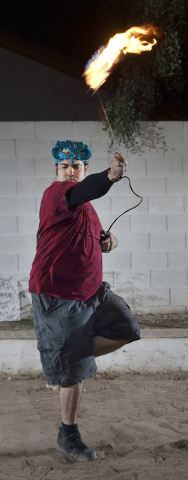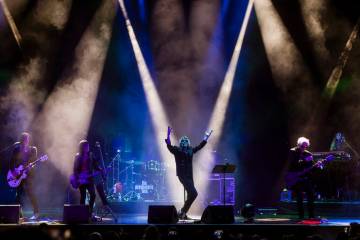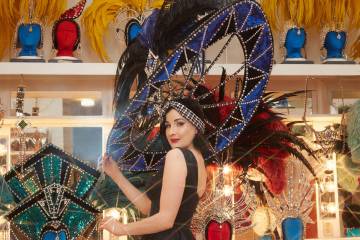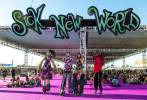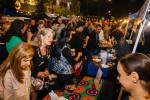Burning Man celebrates a week of independence, creativity — and fire
Even for a mid-August night in Las Vegas, the heat coming from the Summerlin backyard is intense, beyond the normal desert climate. The source? Balls of flame spinning through the air at the end of long stakes and around the perimeter of hula hoops expertly wielded by fire dancers.
Initially, dancers in the Las Vegas-based troupe Illuminalia rehearse their routine with unlit tools. Now, as each person ignites the numerous Kevlar wicks, their faces glow and the smell of kerosene wafts through the yard.
Moving in unison, dancers expertly maneuver flames from metal devices resembling the shape of a lotus flower, nunchucks and 6- to 15-foot rope darts that whoosh loudly through the air.
The dust kicks up in the sandy practice area as performers transition between routines, similar to the conditions they’ll experience in the Black Rock Desert in Northern Nevada when they perform during the annual Burning Man festival that begins Sunday.
The vast stretch of desert 500 miles from Las Vegas is transformed into a functioning city for just over a week. In concentric arcs surrounding the “man,” a 43-foot-tall wooden structure shaped like a human figure, 70,000 Burners camp, dance, create, share and survive. Transportation around the site, which covers more than five square miles, is limited to foot, bicycle or “art car” licensed and pre-approved by the “Department of Mutant Vehicles.”
The festival has grown exponentially, from 350 people in 1990 to about 70,000 by 2013. Tickets remain relatively hard to come by. Back in February, 30,000 main sale tickets, going for $390, sold out in half an hour, according to media accounts. By then, 4,000 pre-sale tickets ($990), 500 “Leonardo da Vinci Art Tickets” ($1,200), and the group sale tickets had already sold out. Four thousand low-income tickets and 1,000 tickets allotted for the OMG Sale in July sold out as well. Though the barren landscape and large-scale art distinguish Burning Man from other festivals, the liberating atmosphere and nonconformist culture draw fans who return for five, 10 or 20 years.
“If anyone asks me to describe Burning Man I’ve always had trouble putting it in a sentence or slogan, so to speak,” says Gary Han, a seven-year Burning Man veteran. He’s also the kitchen manager at the Phoenix Bar, where 20 to 30 Las Vegas Burners meet weekly throughout the year. Though he appreciates the art — it’s one of the main reasons he attends, along with the community — he doesn’t consider himself artistic and participates in the event by volunteering at burn perimeters, at the gate and during the exodus.
By now, some of the principles that created this culture have become etched in the festival’s popular image. The principles of decommodification and radical self-reliance require attendees who venture into the harsh desert to haul everything necessary to survive for a week, including food and water. No money is exchanged on the playa, except to purchase coffee and ice. The result is often months-long preparation for attendees.
Burning Man flips the old Vegas adage on its head: Nothing that happens in Black Rock City stays in Black Rock City. That means a “leave no trace” policy. Every flake of glitter and piece of ash must be hauled away, leaving the playa seemingly untouched by humans. Attendees cannot urinate on the dusty ground or dump their gray water.
Despite the cost, inconvenience and considerable layers of alkaline dust that covers their cars and bodies, Burners say the primary allure of the festival is one of “radical inclusion.”
“(It’s) a place where I can be myself,” a truer, freer self, Illuminalia’s shin, or leader, Jolynn Lopez Mares says.
“It’s complete acceptance from everybody,” adds Illuminalia member Danielle Duffey. “I’ve never experienced anything like that in my life.”
The Burning Man community has spawned numerous local contingents, most notably in San Francisco, where the festival began at Baker Beach in 1986. Though not as well-represented as Northern California, Las Vegas has a fair number of regular attendees represented by a smattering of art projects and theme camps. And, of course, the fire troupe Illuminalia.
Of the wider Vegas Burner community, Lopez Mares says, “they are amazing. I am so lucky to be a part of it. We as a community really do take care of each other.”
Illuminalia’s performance will precede the burning of the man — the genesis and culmination of the festival — on Saturday night.
As volunteers ready the “man,” the Fire Conclave, which includes Illuminalia and 20-plus other troupes, will dance fanned out around the structure like spokes on a wheel, surrounded by Burning Man’s other attendees.
“I think it’s going to be more magical and meaningful than I even expect,” Duffey says.
In the week leading up to this, other structures will burn: temples and art installations large and small. Gifts will be offered and accepted, friendships and relationships built and broken.
The mesmerizing quality of the burn will captivate and draw people in, as it has since its very first year.
“It’s very magical, it’s very alive, in a way,” Lopez Mares says.








